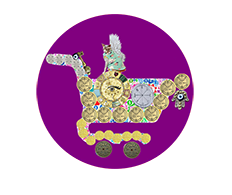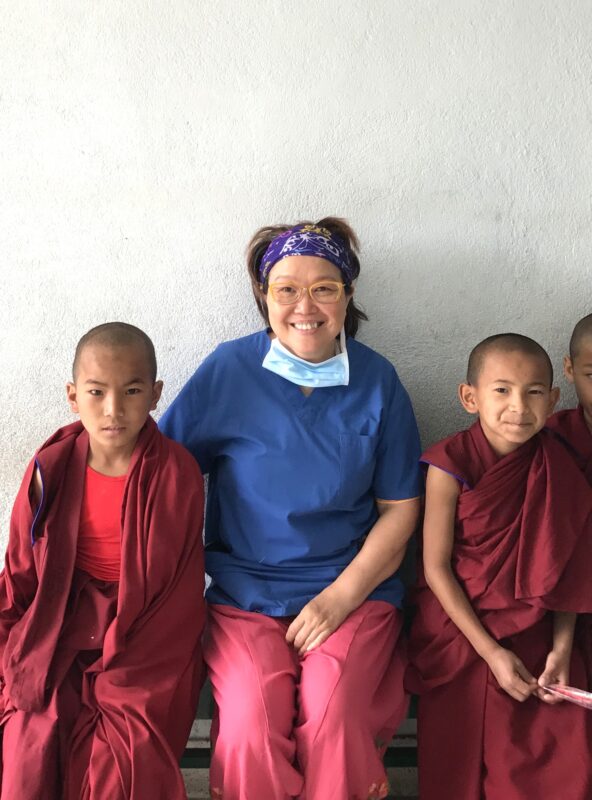Inside Witches Market of LaPaz
Insi
Welcome to Travel, Lifestyle, Art & Photography of Dr Zenaidy Castro Blog. The globetrotting Cosmetic Dentist based in Melbourne Australia. See the world from my photographic perspective. I identify myself as a passionate explorer and adventurer at heart, with strong interest in remote places, unique cultures and different lifestyle.
I hope you enjoy exploring my travel blog and inspired by what you see. Through my photos, I hope to encourage others to get out and explore. To not be scared and to be open to new experiences and civilisations. Because, at the end of the day, travel is about finding experiences that change our minds and widen our perspectives in order to create a more inclusive world. Please feel free to browse thru my blog.
Most of the photographs posted on this blog were taken with my mobile phone. I invite you to browse through my SHOP page to see the real fine art photography that I have created while travelling.
______________________________________________________________________________________________
Within the Mystical Heart of La Paz’s Witches Market
The Witches Market in La Paz, Bolivia, also known as Mercado de Las Brujas, is one of the most fascinating and mysterious places in the world. Nestled in the high-altitude streets of La Paz, this market beckons travelers who are curious about Bolivia’s blend of indigenous traditions, mysticism, folklore, and spirituality. Here, ancient Andean rituals are still alive, sustained by the local Aymara people and practiced with reverence. As visitors stroll through the market’s colorful stalls, they are immersed in a world of magic and mystery unlike any other.
In this article, we’ll take an in-depth look at the Witches Market of La Paz. We’ll uncover its history, its cultural significance, the unique items sold, and the stories that surround it. Whether you’re considering a visit or simply want to explore its charms through words, this guide will transport you to the heart of this mystical marketplace.
The History of the Witches Market
The Witches Market traces its roots back centuries to indigenous Andean culture. Bolivia’s Aymara people have long practiced traditional beliefs that connect spirituality, nature, and the universe. Long before Catholicism arrived in the Americas, the indigenous people engaged in rituals, ceremonies, and offerings to appease the gods and protect themselves from harm.
When Spanish colonization took place in the region during the 16th century, indigenous beliefs merged with Catholic influences, resulting in syncretism—the blending of two religious views. Despite some pressure to convert entirely to Catholicism, indigenous people continued their mystical practices discreetly, preserving these rituals and knowledge through generations. The Witches Market became a hub for these practices, where shamans, healers, and spiritual practitioners came together to trade and access sacred materials.
Today, the Witches Market is not only a place for locals seeking remedies or spiritual help but also a tourist destination where visitors can witness Bolivia’s rich cultural heritage firsthand.
Where Is the Witches Market Located?
The Witches Market is tucked away in the bustling Sagárnaga Street near La Paz’s city center. It sits at a vantage point high above sea level, offering stunning views of the Bolivian capital’s steep streets, mountains, and colonial-style architecture.
The market winds through tight alleys and cobblestone streets, surrounded by shops selling souvenirs and artisanal crafts. Small stalls spill into the sidewalks, packed with items ranging from mystical charms to traditional Bolivian textiles. While the market may look ordinary from afar, it quickly reveals its unique character upon closer inspection.
What Can You Find at the Witches Market?
The Witches Market is famous for the unusual and spiritual items sold there. Many merchants, known as yatiris (traditional Aymara spiritual healers), offer a wide variety of goods essential to local rituals, remedies, and ceremonies. Here’s an overview of some of the fascinating items you can find:
1. Dried Llama Fetuses
One of the most iconic and recognizable items in the Witches Market is the dried llama fetus. These fetuses play a crucial role in Andean ceremonies, particularly “Pachamama” rituals dedicated to Mother Earth.
In Bolivia, many believe that burying a dried llama fetus beneath the foundation of a new home brings good fortune and pleases Pachamama, ensuring stability and blessings for the household. Though they might evoke shock or curiosity from tourists, these items are deeply integrated into local culture.
2. Herbs and Medicinal Plants
Bolivia is a country rich in biodiversity, and this is reflected in the herbs and medicinal plants sold in the Witches Market. Many of these herbs are believed to have curative properties and are used to treat ailments ranging from migraines to digestive issues.
Common remedies include coca leaves (used for altitude sickness), eucalyptus (to ease congestion), and muña (a mint-like herb for stomach pains). Yatiris sell these plants in dried bundles, offering advice on how to use them effectively.
3. Amulets and Talismans
Amulets and talismans are popular items for sale, each imbued with specific energies or purposes. These charms may be for love, protection, prosperity, or luck. They often come in the form of figurines, bracelets, necklaces, or coins crafted from colorful materials.
Many amulets are linked to Andean cosmology, representing symbols of power, nature, or the gods. Buyers seek these items during important life events or simply as gifts for loved ones.
4. Potions and Elixirs
Witchcraft and healing in the market wouldn’t be complete without potions and elixirs. Yatiris concoct mixtures made from exotic ingredients, promising solutions for everything—from attracting romantic partners to warding off evil spirits.
The bottles come with unusual labels and colorful liquids, their contents a blend of herbs, animal parts, and other mystical materials. Buyers may drink, pour, or use these potions during rituals specific to their intentions.
5. Ritual Kits
Ritual kits are packages that include the essentials needed for traditional Bolivian spiritual ceremonies. These kits might include candles, herbs, incense, dried animal parts, and small figurines.
Tourists often purchase smaller ritual kits as souvenirs, but many locals use these items seriously to perform offerings called “mesas”, honoring Pachamama and the mountain spirits called “Apus.”
Who Are the Yatiris?
The yatiris are the heart of the Witches Market. These traditional Aymara spiritual guides act as healers, diviners, and practitioners of ancient Andean traditions. They are considered intermediaries between the physical and spiritual worlds, with knowledge passed down through generations.
Yatiris use coca leaves to perform readings (similar to tarot readings in Western traditions). By interpreting the patterns and direction of coca leaves, they offer advice, predict events, and connect their clients to the forces of the universe.
If you visit, you may encounter young and elderly yatiris wearing traditional garb, often including wide-brimmed hats and scarves, representing their connection to Andean tradition. While some might seem mystical or mysterious, many are happy to explain their practices to curious visitors.
Rituals Performed in the Witches Market
There are several rituals conducted in and around the Witches Market. While some are simple blessings for wealth or prosperity, others are elaborate ceremonies that involve offerings to Pachamama or other deities.
Offerings to Pachamama
One of the most common rituals involves making offerings or “challas” to Pachamama, the Andean goddess of nature and fertility. These offerings are meant to express gratitude and seek her blessings.
A typical offering might include sweets, llama fetuses, incense, herbs, and coca leaves, which are burned or buried as an offering for good health, abundant crops, or household protection.
Fortune-Telling with Coca Leaves
Divining with coca leaves is another well-known ritual that yatiris perform. They throw small handfuls of coca leaves onto a cloth and interpret their arrangement. Many locals visit the market seeking advice on love, business decisions, or personal dilemmas through these readings.
[sp_easyaccordion id=”56016″]
The Spiritual Beliefs Behind the Witches Market
The spiritual practices in the Witches Market are deeply rooted in Andean cosmology. The Aymara people believe in the interconnectedness of all things—humans, nature, spirits, and deities. At the heart of their beliefs lies Pachamama, the Earth Mother who provides fertility and sustenance.
Other important spirits include the Apus, mountain gods, and Ekeko, the god of abundance and prosperity. Bolivians honor these spirits with rituals, offerings, and ceremonies, ensuring balance and harmony between the physical and spiritual worlds.
Tourist Experience at the Witches Market
For visitors, the Witches Market is a unique cultural experience. It’s a must-see destination in La Paz, providing insight into Bolivian traditions, mysticism, and daily life.
Tourists can browse stalls, purchase spiritual souvenirs, or even sit for coca leaf readings with yatiris. While some items like llama fetuses may seem shocking at first, the market is an excellent opportunity to learn about indigenous beliefs and customs.
Tips for Visiting the Witches Market
If you plan to visit the Witches Market, here are a few tips to make the most of your experience:
- Respect Local Customs: Always approach the market with an open mind and respect for the traditions you come across.
- Ask Questions: Most stall owners and yatiris are happy to explain the cultural significance of their items.
- Avoid Haggling Too Much: While bargaining is common in Bolivia, avoid undervaluing spiritual items.
- Prepare for Altitude: La Paz is a high-altitude city, so take precautions to avoid altitude sickness.
The Witches Market as a Window to Bolivian Culture
The Witches Market of La Paz is far more than a tourist destination—it’s a living museum of Bolivia’s indigenous heritage. Here, ancient Andean spirituality continues to thrive, offering an
alternative perspective on life and nature.
Whether you want to explore its mystical charms, learn about local beliefs, or simply shop for unforgettable souvenirs, the market promises an experience unlike any other.
Visit the Witches Market, and you won’t just step into a marketplace—you’ll step into a spiritual world where tradition and magic coexist.
Preservation of Indigenous Practices at the Witches Market
The Witches Market not only serves as a center for commerce but also plays a critical role in preserving and promoting Bolivia’s indigenous culture. In a world where globalization and modernity often overshadow traditional beliefs, the market stands as a testament to the resilience of the Aymara people’s heritage.
Through the practice of ancient Andean rituals, the use of sacred items, and the guidance of the yatiris, the market ensures that cultural knowledge is passed down from one generation to the next. For local communities, it is more than a place to shop—it is a vital space to affirm their identity and honor their ancestors.
The preservation of Andean spirituality is especially significant in the context of Bolivia’s multicultural society. As a nation with a majority indigenous population, Bolivia celebrates its diversity and traditions, and the Witches Market plays an active role in keeping those traditions alive. Tourists who engage with the market are given a unique chance to experience this culture firsthand, promoting greater understanding and appreciation of Bolivia’s indigenous roots.
The Impact of Contemporary Tourism
As one of the most popular attractions in La Paz, the Witches Market has seen an influx of international visitors in recent decades. This surge in tourism has brought benefits and challenges to the area.
On the positive side, visitors have increased awareness of Bolivia’s cultural beauty. Many return home inspired by the deep spirituality and eco-conscious values of the Aymara people, creating a ripple effect of respect and appreciation around the world. Tourism has also provided an economic boost to local vendors and yatiris who rely on the market for their livelihood.
However, this attention has also brought challenges. Some aspects of the market’s culture have been commercialized to cater to tourists’ expectations. For example, some vendors might sell generic “mystical” items that don’t necessarily have authentic roots in Andean spiritual tradition. Despite this, many locals work hard to maintain the essence of the market and ensure that it remains a sacred space rather than a mere tourist trap.
For visitors, it’s important to approach the market with cultural sensitivity and a genuine desire to learn rather than treating it as a spectacle. By asking questions and engaging with yatiris and vendors respectfully, tourists can help preserve the authenticity of this unique cultural site.
Beyond the Market: The Spiritual Side of La Paz
While the Witches Market is without a doubt the spiritual centerpiece of La Paz, it is just one of many ways to explore Bolivia’s mystical traditions. Throughout the city and its surroundings, visitors can find spiritual practices and sacred sites that are deeply connected to Andean cosmology.
The Coca Museum
For a deeper understanding of the significance of coca leaves in Andean culture, a trip to the Coca Museum in La Paz is highly recommended. The museum provides insight into the historical, cultural, and spiritual use of coca leaves, from their medicinal properties to their importance in rituals.
Moon Valley (Valle de la Luna)
Located just a short drive from La Paz, Moon Valley offers visitors a chance to connect with Bolivia’s dramatic landscapes, which often serve as the backdrop for spiritual rituals. Its strange rock formations and eerie beauty evoke a sense of wonder and are said to be tied to mystical energy.
Tiwanaku
For those willing to venture further, the ancient ruins of Tiwanaku, located near Lake Titicaca, offer a profound cultural and spiritual experience. This UNESCO World Heritage Site showcases the ingenuity of pre-Columbian civilizations and their deep connection with the cosmos. Many yatiris believe Tiwanaku is a place of powerful spiritual energy, and ceremonies are often held here to honor Pachamama and the celestial gods.
Spirituality Meets Sustainability
One of the most fascinating aspects of the Witches Market and the surrounding Andean culture is their inherent sustainability. The beliefs and practices of the Aymara people emphasize harmony with nature, encouraging the responsible use of its resources.
For example, the rituals associated with Pachamama reflect a reciprocal relationship with the environment. People give offerings and prayers not only to ask for blessings but also to show gratitude for the nourishment and resources the Earth provides. The preservation of sacred items such as herbs, plants, and animal parts is done with care and deep respect for nature.
This eco-conscious worldview resonates strongly in today’s world, where environmental challenges such as deforestation, climate change, and biodiversity loss threaten the planet. By studying the practices of Bolivia’s indigenous population, visitors may gain valuable insights into living more sustainably and cultivating a deeper awareness of nature’s gifts.
Mysticism and Religion in Bolivia
The Witches Market reflects not only Andean spirituality but also how indigenous belief systems coexist with Catholicism in Bolivia. This blending of belief systems began during colonial rule when Spanish colonizers introduced Christianity to the region. Instead of abandoning their practices entirely, indigenous people integrated Christian symbolism into their existing traditions, creating new forms of worship that honored both the Virgin Mary and Pachamama.
Today, this syncretism can be seen throughout Bolivia, especially in festivals such as El Gran Poder and the Alasitas Festival. During these events, people seek the blessings of both Catholic saints and Andean deities, merging ancient rituals with modern-day celebrations.
This coexistence reflects Bolivia’s rich spiritual diversity and its ability to honor both the past and the present. The Witches Market remains at the center of this cultural interplay, offering a glimpse into how spirituality evolves while remaining deeply rooted in tradition.
How to Approach the Witches Market as a Visitor
Visiting the Witches Market is a unique cultural experience, but it’s important to approach it with the right mindset. Here are some tips for responsible tourism:
- Be Curious, Not Demandful: Ask questions about the items sold and their cultural significance, but avoid pushing vendors to explain their practices if they seem hesitant.
- Respect Ritual Items: Many of the items sold at the market are sacred and deeply meaningful. Avoid making purchases as a joke or novelty.
- Support Local Vendors: When buying souvenirs, look for handmade items crafted by local artisans. This ensures that your money supports the community.
- Speak with Yatiris: If you have the chance, sit down with a yatiri for a coca leaf reading. This will give you a deeper understanding of their spiritual practices and perhaps some personal insights as well.
- Don’t Photograph Without Permission: Many vendors are uncomfortable being photographed, as it can feel intrusive or disrespectful. Always ask for permission before taking pictures in the market.
The Lasting Impressions of the Witches Market
A visit to the Witches Market leaves an indelible mark on those who experience its mystical and cultural richness. For tourists, it’s an opportunity to step outside the familiar and explore a way of life that is deeply connected to nature, spirituality, and tradition.
More than just a marketplace, the Witches Market of La Paz opens a door to understanding Bolivia’s indigenous heritage, where ancient Andean rituals and beliefs remind us of the sacred bond between humanity and the Earth.
As you leave the market, you may carry with you more than just souvenirs—you will likely take home a sense of awe, respect, and reflection that lasts long after your visit. Whether engaging in spiritual ceremonies or simply observing the vibrant life within its stalls, the Witches Market offers a journey into a magical world unlike any other.
The Witches Market: A Symbol of Resilience and Identity
The Witches Market is more than a cultural hub; it stands as a powerful symbol of resilience and identity. For centuries, the indigenous peoples of Bolivia, particularly the Aymara, have faced pressures to abandon their traditions due to colonization and modernization. However, the survival and flourishing of the Witches Market demonstrate their ability to maintain their cultural roots and adapt to the changing world while holding on to their beliefs.
In a globalized society where indigenous practices often risk being overshadowed or forgotten, the market serves as a vibrant reminder of the importance of preserving heritage. It is not just a place to shop or observe; it is a beacon of pride, a celebration of traditions, and a testament to the strength and adaptability of Bolivia’s indigenous communities.
Visiting the Witches Market provides insight into how culture and commerce can coexist harmoniously—how ancient rituals still thrive amid the demands of modernity, allowing Bolivia’s long-standing spiritual practices to remain relevant in a changing world.
The Role of Pachamama in Everyday Life
To understand the significance of the Witches Market, one must understand the central role of Pachamama, or Mother Earth, in the lives of the Aymara people and Bolivians overall.
Pachamama represents fertility, sustenance, and the interconnectedness of all life. She is revered as a life-giving force and protector of the natural world. Offerings to Pachamama are not limited to major ceremonies seen in the marketplace; they are integrated into everyday Bolivian life. Simple gestures, such as spilling the first few drops of a beverage onto the ground as an offering, are common acts of gratitude toward Pachamama.
This deep connection to nature finds expression at every corner of the Witches Market. Every ritual object, dried herb, and mystical charm embodies the relationship between humans and the Earth. By visiting the market, travelers are invited to explore this worldview, one that embraces sustainability, reciprocity, and spiritual harmony. It’s a philosophy that offers valuable lessons in our increasingly disconnected and fast-paced modern lives.
The Witches Market and Indigenous Representation
The presence of the Witches Market acts as a form of empowerment for Bolivia’s indigenous populations, particularly Aymara women who play a prominent role as merchants and practitioners within the market. Many of these women, recognizable by their traditional polleras (wide skirts) and bowler hats, are key figures in preserving and promoting their cultural traditions.
The market provides these women a space to gain financial independence while showcasing their knowledge of ancient spiritual practices. It also challenges societal inequalities and stereotypes, proving that indigenous women hold significant authority in the world of commerce and spirituality.
In a broader sense, the Witches Market serves to elevate indigenous representation in Bolivia’s national identity. The marketplace proudly defies the notion that indigenous practices are relics of the past, instead proving their relevance and importance in modern Bolivian society.
Local Festivities and Their Connection to the Market
The Witches Market cycles through rhythms that are deeply interconnected with Bolivia’s annual festivals and rituals. Seasonal celebrations, such as the Alasitas Festival, have strong ties to the market’s offerings and practices.
During Alasitas, Bolivians purchase miniature versions of objects they hope to gain in real life, such as houses, cars, or money. These symbolic items are blessed by shamans and yatiris in rituals that incorporate elements purchased at the Witches Market. Local vendors prepare special kits for this occasion, blending craft and mysticism to meet the needs of the annual festivities.
Likewise, the Carnival of Oruro, Bolivia’s most famous cultural festival, integrates indigenous spirituality and Catholic traditions. Many participants from around the country make pilgrimages to the Witches Market ahead of Carnival to stock up on ritual items, ensuring their celebrations align with spiritual customs.
These festivals demonstrate how the Witches Market acts as a living thread connecting modern celebrations to their ancient Andean roots.
Navigating the Energy of the Witches Market
Stepping into the Witches Market can be an overwhelming experience, especially for first-time visitors with little exposure to indigenous spirituality. The vibrant stalls, the layered aromas of dried herbs and incense, and the cryptic items hanging from hooks all combine to create an otherworldly atmosphere.
For many people, moving through the market feels like navigating a spiritual crossroads—a place where ancient beliefs speak through objects and rituals. Some find themselves drawn toward particular items without understanding why, while others feel a profound sense of calm amidst the chaos.
The energy of the market is palpable. Conversations with yatiris and vendors often challenge visitors to think about their own lives more deeply—questions of purpose, relationships, and pathways forward become central themes.
Whether you come in search of spiritual healing, cultural immersion, or simple curiosity, the Witches Market has a unique way of connecting its visitors to something larger than themselves.
Why the Witches Market Continues to Captivate Visitors
At its core, the Witches Market represents something timeless: the yearning to understand life’s mysteries and navigate the balance between the known and the unknown. This universal curiosity is what makes the marketplace so captivating to visitors from all over the world.
By combining tradition, storytelling, spirituality, and commerce, the market transcends its physical boundaries and transforms into a symbolic space. Tourists leave with more than souvenirs—they return with glimpses of how other cultures approach life’s fundamental questions, offering perspectives very different from their own.
The cultural exchange that happens at the Witches Market is not one-sided. Locals also enjoy hearing stories from travelers, creating a mutual appreciation for diversity. The marketplace becomes a meeting point for humanity’s shared fascination with faith, ritual, and meaning—a place where curiosity unites people from different corners of the world.
The Market’s Role in Bolivian Tourism
As one of Bolivia’s top tourist destinations, the Witches Market plays an important role in showcasing the country’s heritage. It allows visitors to see firsthand the living traditions of the Andean people, adding depth to their understanding of Bolivian culture.
Tourism helps sustain the market economically, providing vendors with opportunities to share their craft and spiritual practices. Many yatiris have branched out to offer workshops and Coca leaf readings tailored to tourists, which provide cultural insights in addition to supporting their livelihoods.
At the same time, tourism must be managed carefully to maintain the authenticity of the market. Travelers who approach the market with respect and an eagerness to learn contribute positively to its survival.
The Future of the Witches Market
As Bolivia’s indigenous traditions continue to thrive, the future of the Witches Market looks promising. However, it also faces key challenges in balancing modernity, tourism, and the preservation of authenticity.
In some parts of La Paz, rapid urbanization has begun to encroach upon traditional spaces, posing a potential threat to the market’s historical and cultural integrity. Local communities are working to ensure that the market remains a sacred space while adapting to the demands of contemporary commerce.
The Witches Market has already shown remarkable resilience over centuries, evolving with the times while staying rooted in its cultural origins. It remains not just a symbol of Bolivia’s past but also a guide for the future—a reminder of humanity’s ability to harmonize progress with tradition.
Through its vibrant stalls, dedicated yatiris, and the rituals practiced within its walls, the Witches Market continues to offer visitors a profound understanding of Bolivia’s spiritual landscape. For locals, it is a vital part of life; for tourists, it is a gateway to unexplored realms of culture and belief.
In the years to come, the Witches Market will likely continue captivating curiosity and inspiring reverence as a testament to the timeless nature of spirituality and tradition. Whether you’re wandering its cobblestone streets for the first time or revisiting its mysteries, you will always find something magical within.




A Mystical Haven for Spiritual Solutions
For centuries, those in search of a cure for their ailments, a solution to their personal troubles, or assistance to bring wealth into their lives have turned to La Paz’s Witches Market—known locally as Mercado de las Brujas or Mercado de Hechicería. At first glance, this small section of La Paz’s bustling tourist area might not seem extraordinary, but within its crowded stalls and tight alleyways lies a world steeped in history, mysticism, and ancient Aymaran traditions.
Whether someone is dealing with heartbreak and needs to cast revenge on a cheating partner or seeks remedies for illness, spiritual guidance, or blessings for luck or protection, the Witches Market serves as a vital space for both locals and tourists alike. Here, shamans (known as yatiris) and vendors sell everything from potions and medicinal plants to mystical talismans and ritual spells, providing a glimpse into Bolivia’s spiritual dimension.
Unlike a typical marketplace, the Witches Market is a living museum of the region’s enduring indigenous beliefs. Despite urbanization and shifting modern values, the practices rooted in Aymaran cosmology continue to thrive in this magical corner of La Paz.
The Role of Ancient Aymaran Beliefs in the Market
The Witches Market is far more than a shopping destination—it is a sacred space where centuries-old Aymaran beliefs are practiced and preserved. For the Aymara people, spirituality is deeply tied to the Earth, the cosmos, and the balance of energies between humans and nature. Their worldview focuses heavily on living in harmony with Pachamama—the Earth Mother—and appeasing other deities and spirits that govern the natural and spiritual realms.
In Aymaran culture, no event in life occurs without spiritual significance. Whether it’s building a new home, cultivating crops, seeking love, or recovering from illness, rituals are conducted to ensure that balance and goodwill are maintained. This belief system forms the foundation of nearly every product or service offered at the Witches Market.
Visitors to the market find themselves immersed in this unique spiritual ecosystem, where every object and ritual item holds symbolic meaning tied to these ancient customs.
Potions and Spells for Every Problem
No matter what kind of trouble brings someone to the Witches Market, there’s likely a potion, charm, or ritual that promises a solution.
Healing Potions for Physical Ailments
The market offers a wealth of medicinal options crafted from Bolivia’s diverse plant life. Vendors will guide customers to potions, teas, and salves aimed at curing anything from altitude sickness (common in La Paz due to its high elevation) to digestive issues, migraines, and fatigue.
Some items reflect modern remedies tailored to ailments caused by the stresses of contemporary life, while others are ancient mixtures passed through generations. Herbs such as muña, eucalyptus, and coca leaves are particularly common for treating pain and discomfort.
Love and Relationship Rituals
For those suffering heartbreak or hoping to attract their soulmate, the market offers spells designed to bring love, enhance passion, or mend broken relationships. Charms and potions dedicated to romance are often colorful and packaged with symbolic imagery, inviting those who seek emotional healing to take a leap of faith into Bolivian mysticism.
For the heartbroken seeking vengeance, vendors might offer items such as black candles or symbolic effigies for more dramatic rituals aimed at righting emotional wrongs. While revenge spells provoke curiosity in tourists, locals sometimes turn to these practices in moments of profound distress.
Curses and Protection
In difficult times, many turn to the Witches Market to ward off negative energy or defend themselves against spiritual attacks. The belief in the power of curses is widespread in Andean culture, and the market provides tools for both protection and retaliation.
Protection Against Evil
Protection items in the market are designed to safeguard people, homes, and families from the influence of malicious forces, bad luck, and even harmful intentions from others. Common items include:
- Amulets: Small, hand-crafted talismans infused with specific energies to shield the wearer from harm. These may be worn as jewelry, carried on the person, or placed strategically in homes or workplaces.
- Figurines: Intricately carved depictions of Andean deities or protective spirits, such as Pachamama or Ekeko (the god of abundance). These figurines are often blessed by yatiris before being sold, ensuring their protective power.
- Blessed Incense: Incense plays a key role in many Bolivian rituals. When burned, it is believed to repel bad energies, cleanse spaces, and attract positive spirits. Vendors sell bundles of incense alongside instructions for their proper use.
- Herbal Remedies: Certain herbs, such as rue and eucalyptus, are thought to have purifying properties that dispel bad vibrations. These are often sold in dried bundles and used in cleansing ceremonies.
Locals often purchase these items around important events, such as weddings, house moves, or business ventures, to ensure a layer of spiritual protection against unforeseen challenges.
Curses and Retaliation Spells
Just as people seek protection, there are those who visit the market to exact revenge or address perceived injustices through curses or retaliation spells. These practices are not undertaken lightly and are typically guided by the expertise of yatiris, who act as intermediaries between the human and mystical realms. Revenge spells may involve:
- Black Candles: Often associated with releasing negative intentions, black candles are used in rituals to send bad energy back to its source. These rituals must be performed carefully and with proper guidance, as they are believed to carry powerful consequences.
- Effigies or Symbolic Objects: Vendors sell symbolic effigies or dolls that can be used to direct curses. These objects are treated carefully, and rituals involving them often require specific steps and offerings to ensure their effectiveness.
- Coca Leaf Readings: Before proceeding with a curse, many consult a coca leaf reading to determine whether retaliation is justified and to avoid potential karmic repercussions.
While buying items for curses may spark curiosity in tourists, their use is typically governed by strict ethical and spiritual rules. Locals often turn to these measures only in cases of severe emotional or financial distress, believing that the ritual will restore balance and justice.
Medicinal Plants: Nature as a Source of Healing
Bolivia’s rich biodiversity is deeply embedded in the spiritual and medicinal practices of the Witches Market. The market is filled with bundles of dried herbs, powders, and plants that are used in traditional remedies for everything from physical illnesses to emotional struggles.
Common Medicinal Plants Sold in the Market
- Coca Leaves
Coca leaves are among the most ubiquitous items in the market, used for their medicinal, spiritual, and ritual significance. In addition to alleviating altitude sickness, they are chewed or brewed as tea to boost energy and relieve pain. Coca leaves are also used by yatiris during fortune-telling ceremonies, acting as tools to connect with the spirit world. - Eucalyptus
Known for its refreshing scent and purifying qualities, eucalyptus is used to clear congestion and ward off bad spirits. Many visitors purchase eucalyptus bundles during the cold season for natural relief from respiratory issues. - Muña
Often described as Bolivian mint, muña is a plant used to treat stomach ailments and indigestion. Its antibacterial and soothing properties make it a popular remedy among locals and visitors alike. - Ruda (Rue)
Rue is considered a highly protective herb that wards off negativity and cleanses energy. It is commonly sold in dried form and used in both personal rituals and home blessings. - Ch’illka and Other Rare Herbs
The market is also home to rare herbs that are deeply tied to Andean traditions. These plants are used in offerings to Pachamama, as well as for targeted healing ceremonies conducted by spiritual guides.
Magical Talismans and Ritual Kits
The Witches Market is famous for its collection of mystical objects crafted to attract luck, love, wealth, and protection. Many of these items are used in personal rituals performed at home, while others are given as gifts to deliver blessings to loved ones.
Talismans for Love, Wealth, and Success
Amulets and talismans are designed for specific purposes, such as improving romantic relationships, increasing financial prosperity, or bringing general good fortune. Vendors often customize talismans to suit individual needs, ensuring that the energies imbued in the object align with the buyer’s intentions.
For example:
- Ekeko Figurines: Ekeko is the god of abundance and prosperity. Miniature figurines of Ekeko are often sold with tiny bags of food, money, or household items symbolizing wealth and well-being.
- Love Talismans: These charms are crafted with vibrant colors and heart-shaped patterns to attract positive romantic energy. They are popular purchases during festive times or before weddings.
- Business Success Tokens: Merchants and professionals often buy talismans to attract growth and success for their ventures. These come in many shapes, including coins, animal figurines, and other symbols of prosperity.
Ritual Kits for Pachamama Offerings
Ritual kits provide everything needed to perform an offering (challa) to Pachamama or to conduct a personal ceremony. They typically include:
- Dried herbs and plants for cleansing and activating spiritual energy.
- Figurines or symbols representing the spirits being honored.
- Candles, incense, and coca leaves for connection to spiritual entities.
- Instructions or recommended steps for the ritual.
Tourists often buy these kits as souvenirs, but for locals, they are essential tools for maintaining spiritual harmony and renewing their bond with the Earth Mother.
A Market Full of Stories
One of the most captivating aspects of the Witches Market is not just the items for sale, but the stories and traditions behind them. Vendors often share fascinating tales about their products, explaining how each object or plant connects to ancient Andean beliefs. These narratives open windows into the worldview of the Aymara people and their enduring connection to spirituality.
Many yatiris spend years learning the sacred knowledge passed down through generations. They see their role as not only healers and guides but also as protectors of cultural tradition. When tourists or locals seek their advice, the yatiris become storytellers, weaving ancient wisdom into modern lives.
Why Visit the Witches Market of La Paz?
The Witches Market is not just a destination for spiritual exploration; it offers a unique cultural immersion into one of Bolivia’s most vibrant traditions. Whether you’re searching for a mystical cure, learning about indigenous cosmology, or simply seeking to understand Bolivia’s spiritual heritage, the market provides an experience unlike anywhere else in the world.
For locals, it’s a sacred space to address their deepest concerns, hopes, and fears through rituals that connect them to the universe. For visitors, it’s a journey into the mystical Andean worldview—a world where energy flows between humans and nature, and every object holds meaning.
The market serves as a bridge between ancient beliefs and modern curiosity, ensuring that Bolivia’s unique traditions continue to thrive for generations to come. Step into this magical marketplace and see how ancient wisdom can still illuminate the paths of those who enter.




The Alluring Merchandise of La Paz’s Witches Market
The Witches Market of La Paz is not your everyday shopping experience. Far from it—it is a mystical marketplace brimming with unique items, many of which are designed for rituals rooted in ancient Andean practices. The majority of the merchandise sold by vendors is crafted with the specific purpose of influencing various aspects of life, whether it be to bring about health, love, intelligence, protection, happiness, wealth, or even longevity. Additionally, many of these rituals aim to manipulate or connect with the numerous spirits that populate the Aymara world, bridging the gap between the physical and spiritual realms.
Visitors who enter the market may find themselves surrounded by intriguing and even bizarre objects, each with a specific spiritual purpose. The stalls display everything from native herbs and aphrodisiac formulas to dried animal parts and symbolic figurines, which reveal the depth of Aymara cosmology and the complex interplay between humans and the divine entities they believe surround them.
Below, we will delve into some of the more alluring items on offer at the Witches Market, uncovering their significance and purpose in Andean rituals.
Native Herbs: The Healing Power of Nature
Herbs are foundational to the rituals and remedies practiced in the Aymara world. Bolivia’s rich biodiversity provides access to a variety of native plants, and these herbs are harvested and prepared by vendors to aid in healing rituals, protection ceremonies, and even enhancing intelligence or wisdom.
For example:
- Coca Leaves: These are ubiquitous in Bolivian rituals and daily life. In addition to their medicinal use for curing ailments such as altitude sickness, coca leaves are used in spiritual practices to connect with divine spirits, as they are believed to possess sacred energy.
- Rue (Ruda): Believed to ward off evil and cleanse negative energy, rue is often used in blessings for homes and personal protection.
- Eucalyptus: Known for clearing energy and acting as a purifier, eucalyptus can be burned or brewed as tea to address both physical and spiritual concerns.
These herbs are often combined with other elements in rituals to enhance their potency, solidifying their role as indispensable tools in Aymara spiritual practices.
Sacred Candles: Symbols of Intention and Energy
One of the most striking items sold in the market is the black penis candles, which, despite their provocative appearance, carry profound significance in rituals connected to fertility, desire, and energy control. These candles are often used in ceremonies to address romantic or sexual issues, helping individuals manifest their desires or rekindle passion in relationships.
Other candles come in different shapes and colors, symbolizing a variety of intentions: white for purity, green for prosperity, red for love, and black for banishing negative forces. The symbolic burning of these candles represents the act of channeling energy, granting the participant control over their desires and outcomes.
Animal Remains: Connection to Spirits and Energies
The Witches Market is famous (and perhaps infamous) for its assortment of dried animal remains, many of which play crucial roles in Andean rituals. These items are not mere decorations—they are spiritually potent materials believed to carry specific energies that can be harnessed in rituals.
Bolivian Armadillos
Dried armadillos—one of the more unusual items on display—are typically used as offerings in rituals seeking protection. They are believed to possess grounding and defensive energy, acting as spiritual guardians against harm or bad luck.
Parts of Frogs
Various frog parts, such as legs or whole dried frogs, are used in ceremonies aiming to increase fertility, attract wealth, or improve business success. Frogs symbolize growth and abundance due to their connection with water and life cycles.
Dried Turtles, Starfish, and Snakes
These aquatic and reptilian creatures are incorporated into rituals to bring wisdom, longevity, protection, or adaptability. Turtles, in particular, symbolize endurance and long life, making them desirable components of rituals seeking stability and good health.
Owl Feathers
In Aymara beliefs, owls represent intelligence, wisdom, and the ability to see beyond the physical realm. Owl feathers are gathered for rituals designed to enhance decision-making skills, provide spiritual insight, or improve clarity.
While these practices may seem unusual to outsiders, they are deeply tied to Aymara cosmology and the belief in the interconnectedness of all beings—humans, animals, plants, and spirits—within the universe. Vendors respect the spiritual significance of these items and often provide guidance on their proper use.
Figurines for Love and Relationships
One of the most fascinating sections of the market is the variety of figurines tied to romantic and sexual energy. Naked couple figurines, typically carved out of clay or other materials, are used in rituals to promote passion and harmony between partners or to attract a new romance.
These figurines are often accompanied by other items, such as aphrodisiac formulas, scented oils, and herbs, creating a complete toolkit for love rituals. While tourists may chuckle at the bold imagery, locals treat these items with reverence, trusting in their ability to influence relationships and align emotional energy with their desires.
Aphrodisiac Formulas and Love Remedies
The Witches Market is also home to a wide range of love remedies, aimed at helping individuals attract partners, reignite romance, or strengthen bonds. These powerful formulas are crafted with native herbs and other ingredients believed to enhance attraction and sensuality.
Some aphrodisiac formulas are sold in colorful bottles with creative labels and instructions. They may require additional ritual items, such as candles or figurines, to activate their effects fully. Yatiris and vendors often provide detailed instructions for these remedies, emphasizing the importance of intention and focus during the ritual.
Manipulating Spirits: Bridging the Physical and Mystical
One of the central purposes of the items sold at the Witches Market is to manipulate the spirits that populate the Aymara worldview. The belief in spiritual forces is deeply ingrained in Andean culture, and people frequently turn to the yatiris or spiritual practitioners for advice on how to engage with these invisible entities.
Aymara rituals aim to achieve balance within the spiritual realm, either by attracting good spirits or appeasing malevolent forces to ensure a smooth path forward. For example:
- Offerings to Pachamama: Items such as llama fetuses, coca leaves, and figurines are used in offerings to Pachamama, the Earth Mother, to gain her favor and blessings.
- Ward Off Spirits: Dried animals, herbs, and blessed incense are used in ceremonies to repel spirits believed to be disrupting harmony within a home or individual’s life.
- Summoning Help: Owl feathers, starfish, and other symbolic items are offered during rituals aimed at summoning protective spirits that guide and support those in need.
For the Aymara, rituals are not acts of superstition but deeply meaningful practices that maintain their spiritual and emotional well-being. The Witches Market acts as a spiritual pharmacy, providing the necessary tools for connecting with and influencing this mystical world.
Tourist Curiosity and Cultural Exchange
For many visitors, the items sold in the Witches Market range from fascinating to bewildering. While travelers may be unfamiliar with the deeper significance of herbs, figurines, and dried animals, the market offers a unique opportunity to witness the blending of commerce and culture. Vendors are often willing to explain the symbolic meaning behind their products, candidly sharing insights into Aymara beliefs and practices.
Though some tourists purchase these items as curious souvenirs, others take part in rituals themselves, often guided by yatiris who provide coca leaf readings and blessings. This interaction creates a growing cultural exchange that sheds light on indigenous spirituality for outsiders while generating economic benefits for the locals who depend on the market for their livelihoods.
A Space Where Magic Meets Tradition
Exploring the Witches Market of La Paz reveals a fascinating world where ancient beliefs intersect with contemporary needs. From bundles of healing herbs to bold figurines and dried animals, every item holds a spiritual purpose rooted in centuries of ritual practices.
Whether locals come seeking protection, visitors arrive fueled by curiosity, or shamans aim to perform ancient ceremonies, the market remains a rich tapestry of magic, culture, and spirituality. It’s a place where tradition persists, offering a glimpse into the mystical practices that continue to thrive in modern Bolivia.

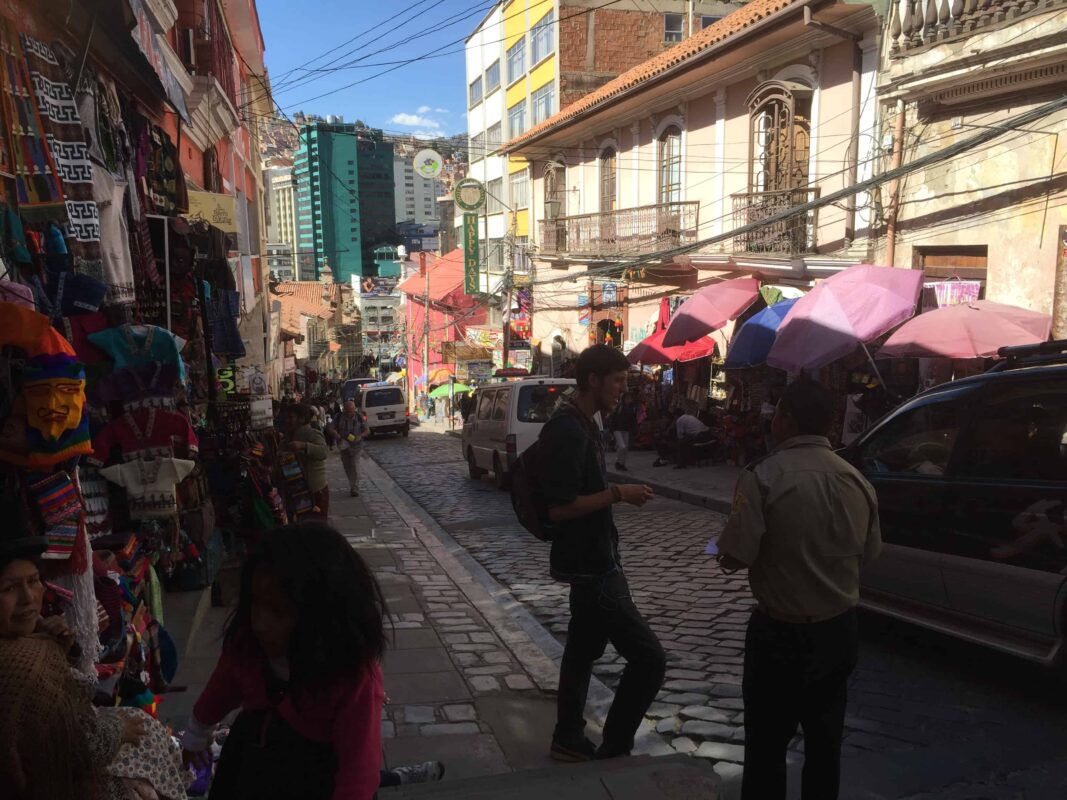

Pre-Mixed Spells and Potions: A Quick Fix for Modern Mystics
In today’s fast-paced world, even the deeply rooted traditions of Bolivia have found ways to adapt. One of the more convenient solutions offered at the Witches Market is the abundance of pre-mixed spells and potions, which come attractively packaged in brightly colored boxes. These spell kits are perfect for those who might not have the time—or the knowledge—to craft a ritual themselves.
The process is simple and hassle-free. All customers need to do is approach a vendor, explain their problem or desire—whether it’s love, health, career success, or protection from harm—and they are handed a pre-packaged care kit designed to address their needs. These boxes often include instructions on how to activate the spell or potion, making it accessible even to those who aren’t familiar with Aymara rituals or Andean spiritual practices.
Inside the kits, you’ll typically find items such as small candles, fragrant incense, herbal mixtures, symbolic figurines, and prepared oils, all carefully chosen to align with the specific purpose of the ritual. For some, these pre-mixed kits are a way to participate in Bolivian spirituality without needing extensive knowledge or preparation. For others, especially locals on the move, they offer a quick and effective way to connect with Pachamama or seek guidance from the spirits without investing time in elaborate ceremonies.
The popularity of these pre-packaged spells reflects a modern interpretation of ancient practices, blending convenience with deeply held beliefs. While traditional rituals often require the expertise of yatiris (spiritual leaders or shamans) and involve carefully curated offerings, the spell kits are designed to put ritual power in the hands of everyday Bolivians, allowing them to maintain spiritual connections in a more accessible, streamlined way. This adaptation underscores how Andean spirituality continues to evolve while preserving its essence in a modern world.
Dried Llama Fetuses: The Pinnacle Offering to Pachamama
As strange as it might seem to travelers unfamiliar with Andean customs, one of the most strikingly unique items sold at the market is the dried llama fetus. These peculiar objects are central to cha’lla—an offering made by Bolivian families to Pachamama, the revered Earth Mother, to ensure protection, health, happiness, and good fortune.
The Ritual Role of Llama Fetuses
The role of the llama fetus in Bolivian culture is deeply symbolic. When constructing a new home or building, it is customary to bury a llama fetus beneath the foundation as a gift to Pachamama. This act is believed to secure the blessings of the fertility goddess, ensuring the household’s safety, prosperity, and continued harmony. The offering also protects builders from accidents during construction and encourages good luck in both the physical space and the business ventures associated with it.
The sacrifice reflects the Aymara people’s intimate relationship with nature and their deep sense of reciprocity—offering something precious to Pachamama in hopes of receiving abundantly in return. As Pachamama governs fertility and the Earth’s well-being, Bolivians seek her blessings to ensure balance, harmony, and prosperity within their lives.
Miscarried Llama Fetuses: A Humane Offering
Walking through the market stalls, travelers will notice that the dried llama fetuses come in a variety of sizes and shapes, which can be startling at first. However, locals emphasize a vital distinction: Bolivians do not kill baby llamas to create these offerings. Instead, the fetuses are collected from llamas that have miscarried naturally. These remains are carefully preserved and dried, ensuring that they are available for community rituals while maintaining respect for the animal.
This humane approach is rooted in Bolivian respect for life, Pachamama, and the llama, which is considered a sacred and valuable creature in Andean culture. Vendors often explain this process to curious visitors, helping them understand the symbolic importance of the offering and reassuring them that no cruelty is involved.
Sizes and Uses
The variety of sizes in llama fetuses serves different purposes. Larger fetuses may signal a grander offering, perhaps for larger properties or enterprises, while smaller ones are often used for more modest rituals. The selection reflects the flexibility of cha’lla ceremonies, where the significance of the ritual is tailored to the scale of the request or problem.
Visitors to the market are often intrigued by this practice, and vendors are usually happy to explain its cultural significance. Some tourists purchase llama fetuses as unusual souvenirs, although vendors prefer to sell them to those who will use them as intended in cha’lla ceremonies.
A Sacred Act of Reciprocity
The use of dried llama fetuses in offerings highlights the central philosophy of reciprocity that governs Andean spirituality. Known as “ayni,” this principle revolves around balance and mutual exchange between humans and the natural and spiritual worlds. Bolivians view cha’lla as an act of giving, not only to Pachamama but also to the spirits that oversee day-to-day life. In return, they hope to receive blessings, protection, and prosperity to sustain their families and communities.
For visitors, witnessing or learning about this ritual offers a profound insight into the harmony that underpins Aymara beliefs—a worldview where every interaction with the Earth and the cosmos carries spiritual significance.
Cultural Curiosity Meets Tradition
As travelers wander through the Witches Market of La Paz, items like pre-mixed spells and dried llama fetuses provide much more than a fascinating glimpse into local customs. They open windows into the living traditions of the Aymara people, who continue to honor their connection to Pachamama and the spirits despite the encroachments of modernity.
The market itself serves as a hub where ancient mysticism and contemporary life coexist beautifully, assuring the continuity of cultural identity while adapting to the needs of a busy and changing world. Whether you’re seeking spiritual advice, authentic artifacts, or just hoping to experience a slice of Bolivia’s rich cultural heritage, the Witches Market offers an unforgettable journey into the magical heart of La Paz.




Honoring Pachamama: The Sacred Ritual of Llama Sacrifice in Bolivia
In the heart of the Bolivian Andes, ancient customs continue to thrive, deeply woven into the fabric of daily life. One of the most poignant and spiritually significant traditions is the offering made to Pachamama, or Mother Earth—a revered goddess who embodies the earth’s fertility, abundance, and protection. This ritual, rooted in Andean cosmology, is not merely symbolic; it is believed to actively invoke the goddess’s blessings, especially in times of transition, hard labor, or new beginnings.
Among the most powerful offerings to Pachamama is the llama sacrifice. This ritual is performed with profound reverence and purpose. In many regions, especially in rural or mountainous areas, llama fetuses—naturally aborted or stillborn—are dried and preserved, becoming sacred gifts presented to the earth. These offerings are not just cultural gestures; they are spiritual contracts between the human and the divine, signifying respect, humility, and the desire for harmony with nature’s forces.
A Gift for Protection and Prosperity
The primary intention behind the offering is to ask for protection from accidents, especially during physically demanding or risky work—such as the construction of homes, roads, or businesses. Builders, miners, and laborers often bury the llama fetus in the foundations of new buildings as a cha’lla (ritual offering), a way of symbolically feeding the earth before taking from her. This act is thought to appease Pachamama, ensuring that no misfortune will fall upon those who work or live within the structure.
But protection is only part of the story. The ritual is also a call for abundance and good fortune. By giving Pachamama something valuable—even a small, lifeless creature—the giver opens a sacred channel, inviting prosperity, fertility of land, and success in ventures.
A Ritual That Crosses Social Lines
While the offering of a dried llama fetus is most commonly practiced by Bolivia’s working class and rural poor—due to accessibility and affordability—the wealthier strata of society often take the ritual further. According to tradition, those who can afford it are expected to offer a live llama to the goddess. This is a grander, more extravagant act of devotion and is usually reserved for significant occasions: major building projects, the founding of large businesses, or ceremonial events marking new chapters in life.
These live sacrifices are highly ritualized and performed with the guidance of Aymara or Quechua shamans, known as yatiris, who serve as mediators between the people and Pachamama. The ceremonies can be elaborate, involving the burning of coca leaves, sweets, alcohol, and other symbolic items, all arranged with spiritual precision.
Ritual and Reciprocity: A Cosmic Balance
The core philosophy behind the offering is based on “ayni”, a Quechua word that refers to reciprocity—the idea that humans must give to the earth in order to receive. This spiritual balance is central to the Andean worldview. By giving back to Pachamama, people do not only honor her—they participate in a cycle of mutual respect and energy exchange, ensuring that the earth remains fertile and generous.
Whether it’s a humble fetus placed discreetly beneath the foundation of a modest shop, or a lavish live animal offering overseen by a spiritual guide, each sacrifice carries the same message: “We remember you, we respect you, we depend on you.”
More Than Superstition: A Living Faith
To outsiders, these practices may seem archaic or even superstitious. But for many Bolivians—particularly Indigenous communities—the offering to Pachamama is a living act of faith, a tangible way to connect with the spiritual world while securing blessings in the physical one. It is neither quaint nor outdated; it is essential, vital, and deeply revered.
Even as Bolivia continues to modernize, the tradition remains firmly intact, practiced by those who see no conflict between the demands of modern life and the reverence for ancestral spirits. In fact, modern entrepreneurs, construction companies, and everyday citizens often combine their technical knowledge with spiritual practices, acknowledging that progress and tradition need not be mutually exclusive.
A Message for the World
The ritual of offering llama fetuses—or live llamas—to Pachamama is more than a religious custom. It’s a profound environmental message, one that the modern world would do well to heed. At its core, this tradition teaches us to value the Earth not merely as a resource but as a living being, worthy of respect, care, and gratitude.
As the global climate crisis continues to unfold, and as natural disasters increase in frequency and intensity, the wisdom of these age-old rituals feels more urgent than ever. Perhaps we, too, need to learn the value of ritual, humility, and reciprocity. Perhaps the future lies not just in innovation, but in reconnecting with nature as something sacred.
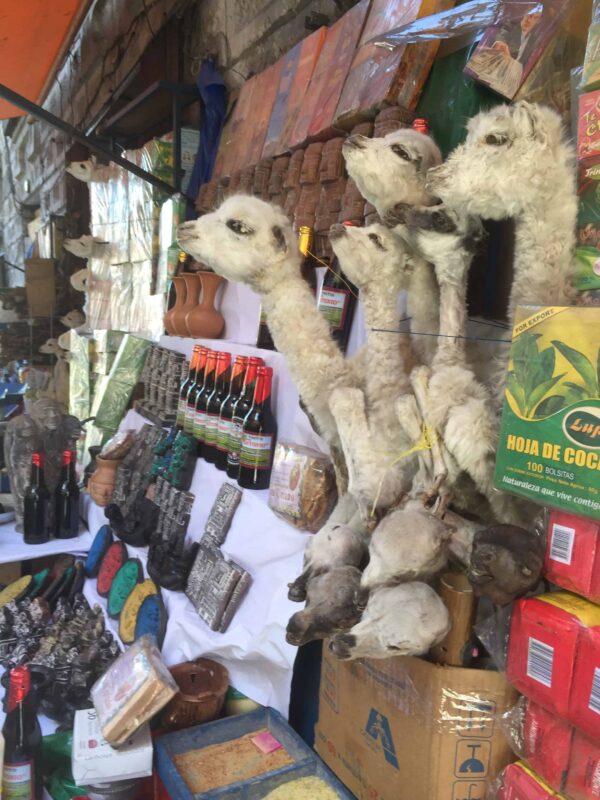
In the bustling heart of Bolivia’s spiritual markets—most famously, La Paz’s Witches’ Market (El Mercado de las Brujas)—you’ll find a surreal, almost otherworldly collection of goods that blur the line between the physical and the spiritual. Here, dozens of stalls line narrow, incense-scented alleys, each one a treasure trove of mystical curiosities and ritual essentials used in ancient Aymara traditions.
Among the items most likely to capture a visitor’s attention are the dried frogs, believed to attract wealth and prosperity when used in specific offerings. These small, shriveled creatures, carefully preserved, are more than morbid oddities—they are tokens of intention, often placed in rituals meant to bring rain, abundance, or financial success.
Elsewhere on the tables, you’ll see bottles of aphrodisiac concoctions, often made from a blend of herbs, roots, exotic extracts, and animal components. Promising passion, love, and restored desire, these mixtures are commonly used in rituals related to relationships, fertility, and union. Many are handmade, passed down through generations of yatiris (traditional healers or shamans), each formula steeped in mysticism and folklore.
Scattered among the potions and powders are statues of deities, spirits, and mythical guardians—many representing Ekeko, the Andean god of abundance and good fortune, or Pachamama, the revered Earth Mother. These statues are not mere decorations; they are conduits for spiritual energy, ready to be activated through offerings, prayers, or cha’llas (ritual blessings).
In addition to the more familiar objects, you’ll also find ritual ingredients as exotic as they are symbolic: colorful feathers, snake skins, dried birds, cactus, amulets, and bundles of herbs—each with its own purpose in the complex universe of Andean magic. Whether the aim is healing, protection, fertility, or cursing one’s enemies, the market holds a ritual solution for nearly every spiritual need.
For the Aymara people, and many other Indigenous communities in the Andes, these rituals and items are not superstition—they are sacred expressions of a worldview that embraces harmony between humans, nature, and the spiritual realm. Buying these items is not about consumerism; it’s about participation in an ancient system of belief where intention, energy, and reciprocity matter.
Wandering through this market is a vivid cultural experience. It’s a place where modern visitors can witness how traditional spirituality remains a thriving, living force in Bolivia today—a reminder that, for many, the unseen world is just as real and important as the one we touch and see.

The Witch Doctors of La Paz: Guardians of Ancient Wisdom in the Modern World
Wandering through the mysterious maze of La Paz’s Witches’ Market (El Mercado de las Brujas), it’s impossible to ignore the figures who move quietly among the dried herbs, llama fetuses, and ritual relics: the witch doctors, or yatiris, keepers of Andean spiritual traditions that date back centuries. Easily identified by their black bowler hats and pouches of sacred coca leaves, these spiritual practitioners are not only relics of the past—they are an active, living presence in Bolivia’s cultural and spiritual landscape.
The yatiris are shamans, seers, and healers all in one—respected intermediaries between the physical world and the spirit realm. Often born into their role through a family lineage or chosen after surviving a lightning strike (a mark of divine selection in Aymara belief), they are said to carry the power to communicate with the supernatural, interpret omens, and manipulate invisible energies that govern health, fortune, and fate.
The Role of the Yatiri in Modern La Paz
Despite the deep-rooted Catholicism that permeates Bolivian society—especially in urban centers like La Paz—traditional Aymara spirituality persists strongly, often coexisting in surprising ways with Christian rituals. On Sundays, while many people attend mass in colonial churches like Iglesia de San Francisco, it’s not uncommon to find yatiris waiting just outside, offering to perform pagan blessings and cleansing ceremonies to ensure that every spiritual base is covered. For many Bolivians, mixing the sacred and the ancient is not contradictory—it’s a form of spiritual insurance.
Although their presence is now a major tourist attraction, yatiris remain deeply respected by local communities. While foreigners may seek a fortune-telling session out of curiosity, Bolivians often consult these spiritual guides for more serious matters: curing illnesses, lifting curses, improving fertility, enhancing business luck, or blessing new ventures with prosperity. A yatiri’s toolkit is vast—ranging from sacred coca leaf readings, smoke offerings, and animal sacrifices, to complex rituals involving chants, charms, and potions.
Not All Magic Is Light
However, not all the rituals performed in the Witches’ Market are rooted in blessings and well-being. According to Luz Pacheco, a professor of anthropology at Universidad Católica Boliviana who specializes in Aymara culture, the darker side of traditional Andean magic is also very much alive. In a revealing 2010 interview with the Huffington Post, Pacheco confirmed that black magic, or “brujería negra,” can be accessed in the Mercado de las Brujas—for a price.
“People will help you destroy someone’s health,” she explained. “They will do rituals to curse a rival business, sabotage a relationship, or bring bad luck to your enemies.” This shadow aspect of Andean mysticism is rarely talked about openly, but locals know it exists, and some turn to it when desperate or deeply wronged.
The objects used in these darker rituals are as varied and complex as their intentions—often involving animal remains, symbolic effigies, graveyard soil, or personal belongings of the target. A curse might be placed through ritual burial, burning, or binding magic, depending on the desired outcome.
Coca Leaves, Smoke, and Sacred Chants
One of the most common and culturally significant tools of the yatiri is the coca leaf. Used as both a sacred plant and a divinatory device, coca leaves are carefully chewed or read after being cast on a cloth. The yatiri interprets their position and patterns to deliver insight—about your love life, your future, or the energy surrounding your current path.
Another frequent offering is the cha’lla, a ritual involving alcohol, fire, incense, and tiny offerings like candies, seeds, or gold-colored trinkets arranged in symbolic patterns. These are meant to honor Pachamama (Mother Earth) and Apus (mountain spirits) in exchange for protection, abundance, and favor.
Many rituals also involve burning herbs, copal resin, or llama fat to release spiritual energy into the air, carried to the gods on plumes of fragrant smoke. Drumming, chanting, and even dances may accompany larger ceremonies, especially those tied to the Andean New Year (June Solstice) or Carnaval.
Between Tourism and Tradition
The booming tourism industry in La Paz has undeniably transformed the Mercado de las Brujas. Many yatiris have adapted their offerings for foreign visitors, who are often drawn in by the mystical atmosphere and unusual merchandise. As a result, some rituals have been simplified or dramatized to meet the expectations of the curious traveler.
Yet, despite this modernization, many yatiris continue to serve their communities with deep seriousness and sacred intention. Their knowledge is not learned from books but handed down orally, often through decades of observation, apprenticeship, and spiritual discipline. In this way, the Witches’ Market is not simply a commercial novelty—it’s a sacred site of living tradition, where the ancient Aymara worldview still pulses just beneath the surface of modern life.
Final Thoughts
The witch doctors of La Paz—with their weathered faces, ancient coca rituals, and reverence for the spirit world—are more than just curious figures in a tourist guidebook. They are guardians of a profound cultural and spiritual legacy, offering a bridge between worlds: between the indigenous past and the global present, between the physical and the metaphysical.
Whether you seek healing, protection, or simply a glimpse into one of South America’s most fascinating spiritual traditions, the yatiris of Bolivia stand ready—coca leaves in hand, flames flickering in offering, and whispers rising to the Andes on sacred smoke.

A Word of Caution at the Witches’ Market: Enter with Curiosity, but Walk with Respect
While the Witches’ Market of La Paz is undoubtedly one of the most captivating and surreal experiences for any traveler in Bolivia—with its aisles of dried llama fetuses, ceremonial herbs, and mystical talismans—it’s important to remember that this is not merely a tourist attraction. What may appear exotic or theatrical to the untrained eye is, for the Aymara people, a deeply sacred space rooted in centuries-old beliefs and spiritual practices.
The vendors you’ll meet here—many of them spiritual practitioners or direct descendants of shamans—take their work seriously. These items are not souvenirs, but tools of ritual power, used in offerings to Pachamama, protective ceremonies, healing rites, and even sorcery. Every bundle of herbs, every clay figurine, every dried animal part has symbolic weight and energetic purpose.
While many stallholders are generous with their knowledge and willing to answer respectful questions, it’s important to ask before you touch and to always request permission before taking photos. Picking up ritual objects carelessly or snapping shots without consent isn’t just considered rude—it can be interpreted as a spiritual offense.
And yes, local lore warns that those who show disrespect may find themselves on the receiving end of a curse. Whether you believe in such things or not, it’s wise to err on the side of reverence. After all, in a place where the boundary between the seen and unseen is as thin as incense smoke, a little humility goes a long way.
So tread thoughtfully. Come with open eyes, but also with an open heart. The Witches’ Market is a gateway into an ancient worldview where everything—spirit, earth, ritual, and energy—is connected. Treat it as such, and you may just walk away with more than curiosity satisfied—you might gain a new respect for the mysteries that still shape the world.
⚠️ You’ve Been Warned.
Life should not be a journey to the grave with the intention of arriving safely in a pretty and well preserved body, but rather to skid in broadside in a cloud of smoke, thoroughly used up, totally worn out, and loudly proclaiming “Wow! What a Ride!”
– Hunter S. Thompson
Whether you’re seeking modern elegance Abstract art or timeless charm of black and white photography, Dr Zenaidy Castro’s diverse range of art and photographic prints and artpieces ensures you find the perfect match for your unique vision. Explore our abstract art and photographic collection and see how our artworks and photographs can transform your establishment into a visual masterpiece.
[sp_easyaccordion id=”54074″]


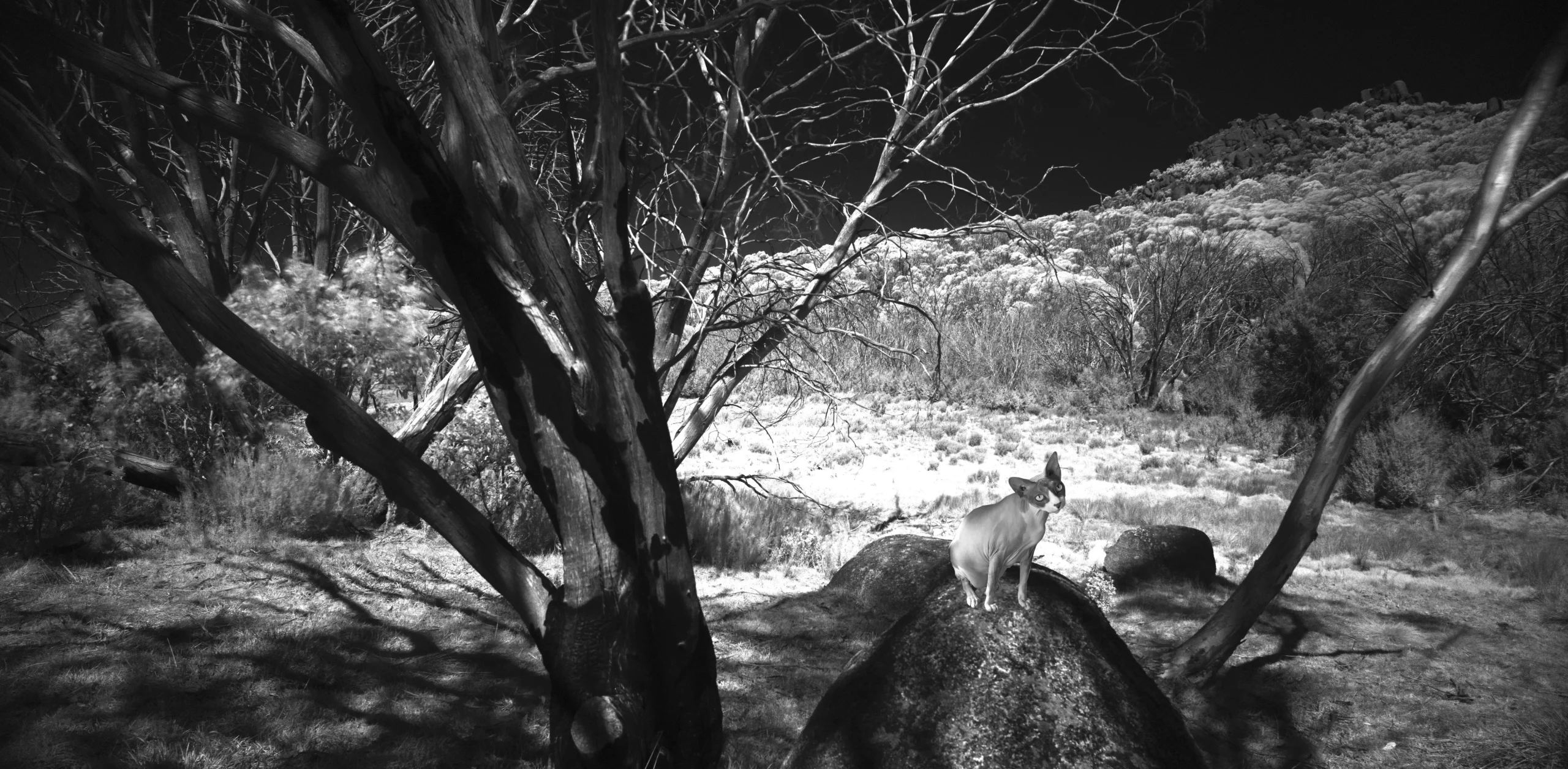
═══════════════════════════════════════════════════
At Heart & Soul Whisperer Art Gallery, every coloured and black and white photograph tells a story beyond sight—an emotional journey captured in light, shadow, and soul. Founded by visionary artist Dr Zenaidy Castro, our curated collections—spanning landscapes, waterscapes, abstract art, and more—offer a timeless elegance that transcends fleeting trends. Whether enriching private residences, corporate offices, healthcare facilities, hospitals, or hospitality spaces, our artworks are designed to transform environments into sanctuaries of memory, beauty, and enduring inspiration. Let your walls whisper stories that linger—reflections of art, spirit, and the love that connects us all.
[sp_easyaccordion id=”54056″]
═══════════════════════════════════════════════════
Tag: Travel destination, Travel stories, Travel Blog, Cultural travel, Travel Guide, Adventure Travel, Nature Travel, Street Photography, Wanderlust, Travel Photography, Adventure, World Traveler, Globetrotter, Travel Life, Explore The World


